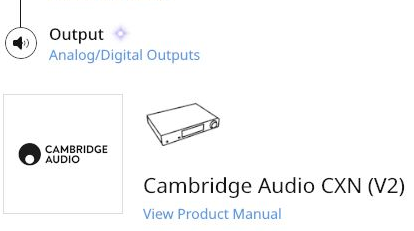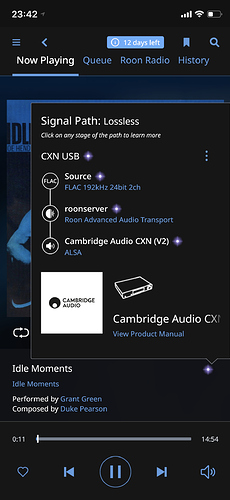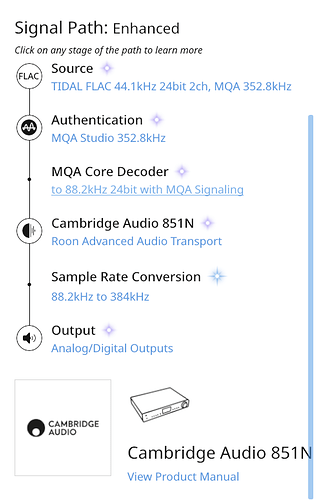At the price point I find the CXN V2 hard to beat. Nice display. Easy controls. Seamless integration with Spotify, Tidal, Roon and my nas. I also use digital out to a dac3b and on Roon path it shows 384khz, but on my dac it displays the original sample rate of the music played.
Well than Cambridge should be able to fix that with a firmware update
I think there is no way to tell-apart if a user is utilizing the built in DAC (analogue output) or the digital output – both seem to be active all the time. A user may even choose to use both connection types at the same time.
As @BlackJack says, I don’t think the CXN has any way of knowing which output you are using. They could implement something that allowed you to turn on or off outputs, or designate which you were using; but I doubt it would be high on their priority list for the subset of CXN buyers who are using Roon and the pass through digital outputs and are bothered about it…
Yeah you are likely correct
The CXN v2 is still upsampling but the USB connection does not have the capacity to report that back.
I can verify that the cxn upsamples everything to 24bit 384. then
Lowers the rate on spdif outs.
The v1 and cxn v2 explain that nothing is processed on digit outs.
They are WRONG.
I have an adi 2 dac fs.
When I play a 16bit 44100khz file on the cxn connected to rme adi
Using coax out.
the adi 2 dac reports sync 44100 24bit?
So it processing a 16bit and sampling to 384khz 24bit then outputting
To the rme adi at 44.100 24bit
Hrmmmm. Cambridge aren’t being honest.
The cxn screws with the audio. PERIOD.
Thanks a lot for your persistence and posting your final findings. I too was wondering about the signal path information Roon was showing and I found this thread very helpful. I too can verify the CXNv2 sends the same format PCM to the digital outputs as the original files.
I pulled a non-Cambridge DAC (a Sony E9000ES that displays the audio format) out of the closet to double check the behavior myself. I can verify that when I connect my Sony to either the coax or optical digital outputs of the CXNv2 that the Sony reports the same format as the source files. I tested with my local 16/44, 24/96, and 24/44 FLAC files as well as a variety of FLAC streams from Tidal and they all come through as expected.
@Guy_Gampell1 did you get a reply from CA? I have facing the same issue too.
In the stuff above is the explanation , watch the CA. Video above.
If you look at your signal path the conversion is below RAAT / CA851 step hence nothing to do with Roon, RAAT is the last Roon step as it passes to the network
I use a CXN to feed by coax to my headphone amp/ DAC , Audiolab M DAC, which has a sample rate indicator on its display screen
If I listen 192 source I see 192 at the DAC. CA tell us that the digital outputs are bit perfect
CA DACs use ATF2 , (and have for years , DAC Magic 100 etc) it internally upsamples the signal to 384 on the way to the DAC chip. The coax and SPDIF optical outputs bypass this process.
If you download the Reference Manual ( not the User Manual) it is clearly defined
Ok, so that means it’s working as it was designed to. 
Yes, exactly. I had a CXN v2 and now an 851 with exactly the same behavior. Cambridge RAAT implementation appears to report back the internal up-sampling which not many other DACs do. My two Elac discovery music servers don’t do it even though it is documented that there is an up-sampling stage at work.
The signal path with the Cambridge shows as enhanced whereas the Elac signal pathe shows lossless, so go and think about it…
When I connect my external DAC to the optical out of the Cambridge Azur it correctly shows the frequency of the source be it 44.1 or all the way up to 192 Hz. This is all valid for the latest firmware on the Azur and current Roon version.
I tried the CXN v2 spdif output into my RME ADI2, it sounded very poor IMO.
Every source I had sounded better, Nuc PC, Pi4, Pi4/with Pi2aes hat, Pioneer n70a, etc.
The CXNv2 is made to be used as a DAC and preamp.
I would not use its spdif output.
yes, I agree, most of the time for streaming, I use a Chromecast Audio, connected via digital cable to an optical input on my Edge A. the CXN v2 is not often powered up these days . I agree I could use the onboard DAC and go analogue in to the Edge A, but I like the result with Chromecast Audio so much, I have no incentive. I also use the Roon feature to case visual graphics to my TV display while the audio goes to CCA.
I can see the CXNv2 goin up on fleabay some time soon… for me it’s more a less a deadweight now.
I can confirm CXNv2 is not delivering upsampled to external DAC when connected via TOSLINK.
Roon indeed notes CXNv2 is doing up sampling to 384 (which is probably the input to the built-in DAC), but my external DAC shows the original source rate at all times. CDs are 44.1, Some Qobuz stuff is 192….
I don’t know what the SDK for Roon-ready devices is supposed to do in this case. It sure is confusing as it implies the external DAC got something other than the streamed bots (reclocked).
This has been commented on previously , Cambridge Audio has up-sampled everything internally for years , going back as far as the DAC Magic 100. Its a major selling point !!
In this instance on the CXN V2 it reports that up-sample back to Roon so it shows on the file path.
Any digital input/output is before this up-sampling, I run a co-ax out to my Headphone amp and that reports the same as the file
OK, horse beaten to death until it sounded better than CD quality 
Strict curiosity from my side: What is the “correct” behavior (reporting-wise) for a Roon Ready device in this case? A stated design goal [1] for RAAT is “ 1. Promote honesty regarding what is happening to the audio. RAAT is tied to Roon’s signal path feature. We work with manufacturers to make sure that potentially destructive processing stages like software volume controls are exposed to interested users, and that processing isn’t being concealed or hidden.” I would expect the signal path for the case in which the digital out is just a pass through to not even mention the upsampling. Reporting bug, perhaps?
Read above:
There is currently no distinction between up-sampled analog and the pass through digital outputs:

I don’t see how Roon could show correct values without splitting up the signal path in as many branches (as many as there are different outputs {analog, coax up to 192kHz, TOSLINK up to 98kHz down-sampled if needed}?) as needed. Especially in cases where a device doesn’t really communicate back (outputs don’t get managed/switched), this had to be done on assumptions. Is this really needed? Would it make Roon a better product?
Argh! Deleted by mistake.
I was saying I don’t know the SDK or the internals. But it’s not hard to imagine a CA reporting bug.
But if you’re pretty sure the machine just can’t tell the outputs apart, well… so be it.

